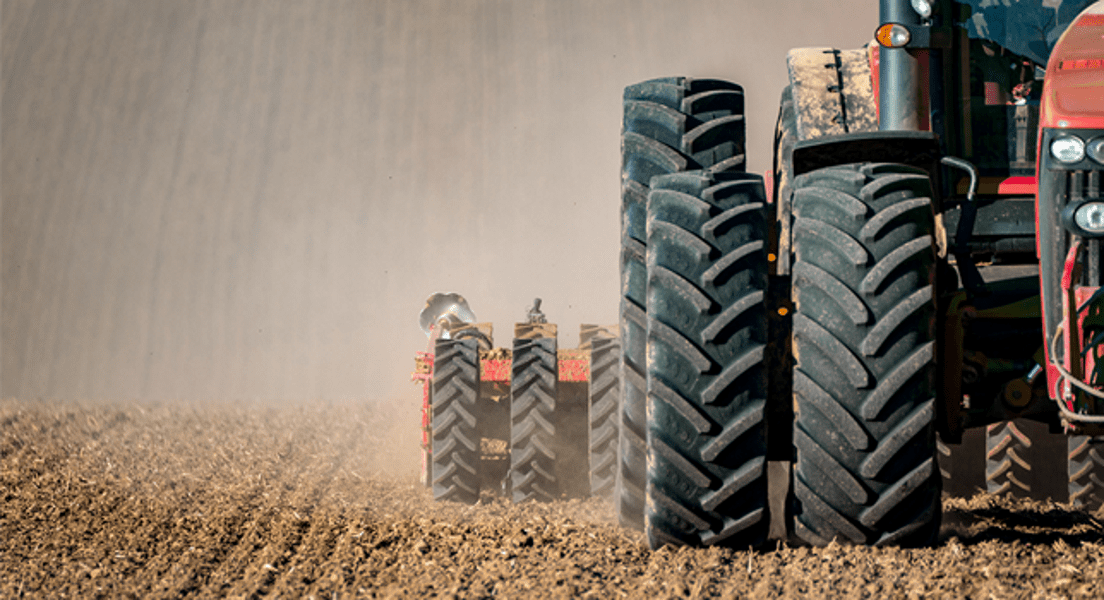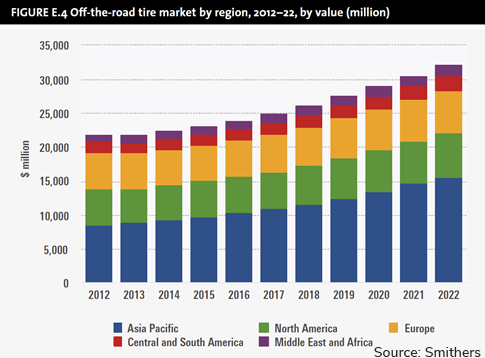Market Report
The Future of Off-the-road Tires to 2024

Technology innovations and developing end-user requirements are driving the off-the-road tires market into uncharttered territory, presenting fresh challenges to manufactures and suppliers.
The global market for off-the-road (OTR) tires is estimated to be over 3.7 million tons in 2017, a value of $24.8 billion. Smithers new market report - The Future of Off-the-Road Tires to 2022 - forecasts in value terms an annual growth rate of 5.2% to 2022, climbing to a value of $32 billion.
Technological advancements and market changes in the OTR tire industry are presenting several challenges to manufacturers and suppliers. From an end user’s perspective, the imperative is to continue to drive efficiency and productivity, even as equipment gets larger and places additional stress and performance demands on the tire.
Over the next five years, the industry is poised to enter a transformative era and Smithers identifies the areas of the market that will witness major changes and quantifies the impacts:
All regions are expected to grow over the next five years, most noticeably in Asia. As with many other tire markets, the relatively strong economic performance of the emerging and developing economies greatly influences the distribution of growth opportunities. The share of OTR tire product volume will continue its ongoing shift away from the mature economies of North America and Europe and toward emerging and developing economies, mainly those in the Asia-Pacific region, which will rapidly approach 50% of the global market over the forecast period.

Key OTR-relevant commodities are experiencing decreases in global consumption under increasing environmental and regulatory pressures. In the US the Clean Power Act of 2014 may have had some admirable goals, but it eliminated dozens of coal mining businesses. This may be set to change, as the US coal business could see improvements due to the more relaxed attitude toward its mining and use by new political leadership in Washington.
Some original equipment manufacturers - especially Caterpillar - have expressed an interest in uniform OTR performance standards, including parameters for wear, speed, load, traction, and temperature resistance. So far in the European Union there is no strong lobby for OTR performance to persuade the European Commission to work on standardization or labelling requirements, and the OTR industry itself has expressed little interest.
There is potential for further regulatory attention to be paid to certain OTR tires in relation to restrictions on CO2 emissions, vibration, noise, and road damage if they are of a similar nature to what is currently used on roads.
There are many dimensions of technological change within the industry as it strives towards enhancing essential OTR tire attributes:
A number of technological trends are presenting opportunities to meet emerging needs in the marketplace. New compounds, materials, and integrated value-added technologies - like embedded sensors - should help OTR tires become more durable, efficient, and long lasting, as applications become more demanding. At the same time, new opportunities appear to be opening up to shrewd market participants in the areas of sustainability and standardization, for example passenger and commercial tires, where there has been relatively little activity compared to other tire product segments so far.
Giant OTR tires for mining and construction are almost all produced at a few plants in the world, and take some time to build and cure. It takes more than a day to build one giant OTR tire and cure it in a press. The moulds can take years to produce, and there are only a few companies in the world with the technology or expertise to build them.
Producers such as Bridgestone, Michelin and Yokohama have invested heavily in the past few years to increase their production capacity. Encouraged by growth forecasts and announcements of new plants, suppliers such as Cabot are now focusing more attention on OTR and expanding capacity.
It is possible that closer partnership with customers – like Caterpillar and Continental – and sustained fieldwork would help perceptive OTR producers become more agile, and become better at adjusting capacity for growth or contraction. Sustainability is another area of potential development, which in the case of large OTR tires is less about extending service life through retreading and more about recyclability, where some more innovative methods are entering the market.
As the market moves forward, OTR tire customers want more than just a tire and related services - they want predictive analytics to help them maximize productivity. Predictive analytics enable customers not only to track tire and rim performance, but also to manage the life cycle cost of tires and forecast the demands of a tire program. This leads to lower production unit costs and ultimately improves their net profitability. Major fleets are becoming more focused on the total cost of tire ownership, moving away from a purely product-centric or transactional view, where they only evaluate a tire’s purchase price, to assessing the overall costs. Using technology and data to analyze product value and then making decisions based on this data to maximize uptime and increase profitability will be critical across 2017-2022.
The Future of Off-the-Road Tires to 20222 maps out the future of the market, including statistical analysis and industry perspectives and strategies from leading tire manufacturers Michelin, Continental, Bridgestone, Goodyear and many more. For more information, download the brochure.